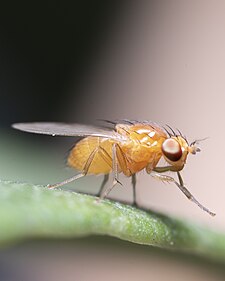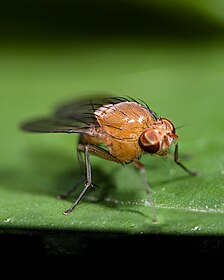
Back Drosophila melanogaster ACE Drosophila melanogaster AN همجة الأبحاث Arabic ذبابه فاكهه شائعه ARZ Drosophila melanogaster AST Плодова мушица Bulgarian Vinska mušica BS Mosca del vinagre Catalan Drosophila melanogaster CEB Octomilka obecná Czech
| Drosophila melanogaster | |
|---|---|

| |
| Fruit fly feeding off a banana | |
| Scientific classification | |
| Domain: | Eukaryota |
| Kingdom: | Animalia |
| Phylum: | Arthropoda |
| Class: | Insecta |
| Order: | Diptera |
| Family: | Drosophilidae |
| Genus: | Drosophila |
| Subgenus: | Sophophora |
| Species group: | melanogaster |
| Species subgroup: | melanogaster |
| Species complex: | melanogaster |
| Species: | D. melanogaster
|
| Binomial name | |
| Drosophila melanogaster | |
| Synonyms[2] | |
|
List
| |


Drosophila melanogaster is a species of fly (an insect of the order Diptera) in the family Drosophilidae. The species is often referred to as the fruit fly or lesser fruit fly, or less commonly the "vinegar fly", "pomace fly",[a][5] or "banana fly".[6] In the wild, D. melanogaster are attracted to rotting fruit and fermenting beverages, and are often found in orchards, kitchens and pubs.
Starting with Charles W. Woodworth's 1901 proposal of the use of this species as a model organism,[7][8] D. melanogaster continues to be widely used for biological research in genetics, physiology, microbial pathogenesis, and life history evolution. As of 2017, six Nobel Prizes have been awarded to drosophilists for their work using the insect.[9][10]
Drosophila melanogaster is typically used in research owing to its rapid life cycle, relatively simple genetics with only four pairs of chromosomes, and large number of offspring per generation.[11] It was originally an African species, with all non-African lineages having a common origin.[12] Its geographic range includes all continents, including islands.[13] D. melanogaster is a common pest in homes, restaurants, and other places where food is served.[14]
Flies belonging to the family Tephritidae are also called "fruit flies". This can cause confusion, especially in the Mediterranean, Australia, and South Africa, where the Mediterranean fruit fly Ceratitis capitata is an economic pest.
- ^ Meigen JW (1830). Systematische Beschreibung der bekannten europäischen zweiflügeligen Insekten. (Volume 6) (PDF) (in German). Schulz-Wundermann. Archived from the original (PDF) on February 9, 2012.
- ^ "Drosophila (Sophophora) melanogaster Meigen, 1830". Catalogue of Life. Species 2000: Leiden, the Netherlands. Retrieved May 2, 2024.
- ^ "Drosophila | insect genus". Encyclopedia Britannica. Retrieved October 30, 2021.
- ^ "Vinegar Flies". Penn State Extension. Retrieved October 30, 2021.
- ^ a b Green MM (September 2002). "It really is not a fruit fly". Genetics. 162 (1): 1–3. doi:10.1093/genetics/162.1.1. PMC 1462251. PMID 12242218.
- ^ Schilthuizen, Menno (April 28, 2015). "Semen's Chemical Cocktail Can Hijack a Mate's Brain". Discover. Retrieved September 11, 2023.
Even in the ejaculate of the lowly banana fly Drosophila melanogaster, researchers have identified no fewer than 133 different kinds of proteins.
- ^ T.H. Morgan's Nobel Prize biography mentioning C. W. Woodworth
- ^ Holden B (January 1, 2015). Charles W. Woodworth: The Remarkable Life of U.C.'s First Entomologist (1st ed.). Brian Holden Publishing. pp. 135–137. ISBN 978-0-9864105-3-6.
- ^ "Nobel Prizes". The Guardian. October 7, 2017.
- ^ "FruitFly-ResearchGate".
- ^ Sang JH, Reeve EC (June 23, 2001). "Drosophila melanogaster: The Fruit Fly". Encyclopedia of genetics. USA: Fitzroy Dearborn Publishers, I. p. 157. ISBN 978-1-884964-34-3. Retrieved July 1, 2009.
- ^ Baudry E, Viginier B, Veuille M (August 2004). "Non-African populations of Drosophila melanogaster have a unique origin". Molecular Biology and Evolution. 21 (8): 1482–91. doi:10.1093/molbev/msh089. PMID 15014160.
- ^ Markow TA (June 2015). "The secret lives of Drosophila flies". eLife. 4. doi:10.7554/eLife.06793. PMC 4454838. PMID 26041333.
- ^ "Vinegar Flies, Drosophila species, Family: Drosophilidae". Department of Entomology, College of Agricultural Sciences, Pennsylvania State University. 2017. Retrieved July 20, 2017.
Cite error: There are <ref group=lower-alpha> tags or {{efn}} templates on this page, but the references will not show without a {{reflist|group=lower-alpha}} template or {{notelist}} template (see the help page).
© MMXXIII Rich X Search. We shall prevail. All rights reserved. Rich X Search